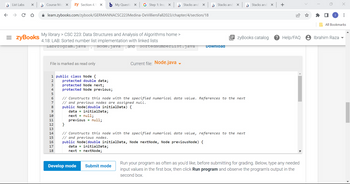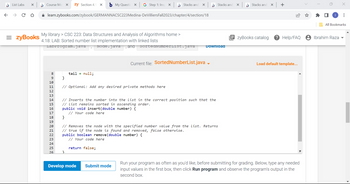
Concept explainers
Step 1: Inspect the Node.java file
Inspect the class declaration for a doubly-linked list node in Node.java. Access Node.java by clicking on the orange arrow next to LabProgram.java at the top of the coding window. The Node class has three fields:
- a double data value,
- a reference to the next node, and
- a reference to the previous node.
Each field is protected. So code outside of the class must use the provided getter and setter methods to get or set a field.
Node.java is read only, since no changes are required.
Step 2: Implement the insert() method
A class for a sorted, doubly-linked list is declared in SortedNumberList.java. Implement the SortedNumberList class's insert() method. The method must create a new node with the parameter value, then insert the node into the proper sorted position in the linked list. Ex: Suppose a SortedNumberList's current list is 23 → 47.25 → 86, then insert(33.5) is called. A new node with data value 33.5 is created and inserted between 23 and 47.25, thus preserving the list's sorted order and yielding: 23 → 35.5 → 47.25 → 86
Step 3: Test in develop mode
Code in main() takes a space-separated list of numbers and inserts each into a SortedNumberList. The list is displayed after each insertion. Ex: If input is
77 15 -42 63.5
then output is:
List after inserting 77: 77 List after inserting 15: 15 77 List after inserting -42: -42 15 77 List after inserting 63.5: -42 15 63.5 77
Try various program inputs, ensuring that each outputs a sorted list.
Step 4: Implement the remove() method
Implement the SortedNumberList class's remove() method. The method takes a parameter for the number to be removed from the list. If the number does not exist in the list, the list is not changed and false is returned. Otherwise, the first instance of the number is removed from the list and true is returned.
Uncomment the commented-out part in main() that reads a second input line and removes numbers from the list. Test in develop mode to ensure that insertion and removal both work properly, then submit code for grading. Ex: If input is
84 72 19 61 19 84
then output is:
List after inserting 84: 84 List after inserting 72: 72 84 List after inserting 19: 19 72 84 List after inserting 61: 19 61 72 84 List after removing 19: 61 72 84 List after removing 84: 61 72


Trending nowThis is a popular solution!
Step by stepSolved in 4 steps with 4 images

- Linked List, create your own code. (Do not use the build in function or classes of Java or from the textbook). Create a LinkedList class: Call the class MyLinkedList, (hint) Create a second class called Node.java and use it, remember in the class I put the Node class inside the LinkedList Class, but you should do it outside. This class should haveo Variables you may need for a Node,o (optional) Constructor Your linked list is of an int type. (you may do it as General type as <E>) For this Linked List you need to have the following methods: add, addAfter, remove, size, contain, toString, compare, addInOrder. This is just a suggestion, if you use Generic type, you must modify this Write a main function or Main class to test all the methods,o Create a 2 linked list and test all your methods. (Including the compare)arrow_forwardThe two classes you will create will implement the operations defined in the interface as shown in the UML class diagram above. In addition, BinarySearchArray will implement a static method testBinarySearchArray() that populates the lists, and lets the user interactively test the two classes by adding and removing elements. The parameter BinarySearch can represent either class and tells testBinarySearchArray which class to test. Steps to Implement: 1) To get started create a new project in IntelliJ called BinarySearch. Add a class to your project called BinarySearchArray. Then add another class BinarySearchArrayList and an interface called BinarySearch. The interface BinarySearch includes public method stubs as shown in the diagram. You are allowed to add BinarySearchArrayList to the same file as BinarySearch but don't add an access modifier to this class, or for easier reading, you can declare the classes in separate files with public access modifiers. Only the class…arrow_forwardDesign a class called Post. This class models a StackOverflow post. It should have properties for title, description and the date/time it was created. We should be able to up-vote or down-vote a post. We should also be able to see the current vote value. In the main method, create a post, up-vote and down-vote it a few times and then display the the current vote value.arrow_forward
- Given main(), define an InsertAtEnd() member function in the ItemNode class that adds an element to the end of a linked list. DO NOT print the dummy head node.arrow_forwardwrite a program for a library automation which gets the isbn number, name, author and publication year of the books in the library. the status will be filled by the program as follows: if publication year before 1985 the status is reference else status is available, the information about the books should be stored inside a linked list. the program should have a menu and the user inserts, displays, and deletes the elements from the menu by write a selecting options. the following data structure should be used. struct list char isbn[ 20 ]: char namei 20 ]. char authori 20 ]: int year; char status[200j: struct list "next, jinfo, wedoad n un posn ag pinogs nuu sulnogoj l press 1. to insert a book press 2. to display the book list press 3. to delete a book from listarrow_forwardIt is python language Write the code that creates a new Node class. It will store data and next attributes. You only need to create the __init__ method. data and next variables will have default values, both set to None. Assume you are using the Node class from the previous connection to create a LinkedList. You have the code below, create a method that removes the first node from the LinkedList. class LinkedList: def __init__(self): self.head = None Based on the code from the last two questions, create a new LinkedList. Add 2 values to the LinkedList (there is an add method that accepts data as an argument, called add). Then call the removeFront method created in the previous question. Based on the previous questions, create a Queue class that uses the LinkedList for its data storage. Create the __init__, isEmpty, insert, remove, and size methods. Assume that LinkedList class has the add, removeFront and size methods defined. Based on the LinkedList code already…arrow_forward
- Create class Node in a file named Node.java. This class has the following properties: Public fields previous and next, pointing to the previous and next nodes in the list, respectively. Private field data, defined as a reference to an object of any type. Public constructor that takes the node’s data as an argument. Public function GetData() that returns the node’s data.arrow_forwardComputer science questionarrow_forwardInstruction: To test the Linked List class, create a new Java class with the main method, generate Linked List using Integer and check whether all methods do what they’re supposed to do. A sample Java class with main method is provided below including output generated. If you encounter errors, note them and try to correct the codes. Post the changes in your code, if any. Additional Instruction: Linked List is a part of the Collection framework present in java.util package, however, to be able to check the complexity of Linked List operations, we can recode the data structure based on Java Documentation https://docs.oracle.com/javase/8/docs/api/java/util/LinkedList.html package com.linkedlist; public class linkedListTester { public static void main(String[] args) { ListI<Integer> list = new LinkedList<Integer>(); int n=10; for(int i=0;i<n;i++) { list.addFirst(i); } for(int…arrow_forward
- Linked List, create your own code. (Do not use the build in function or classes of Java or from the textbook). Create a LinkedList class: Call the class MyLinkedList, (hint) Create a second class called Node.java and use it, remember in the class I put the Node class inside the LinkedList Class, but you should do it outside. This class should haveo Variables you may need for a Node,o (optional) Constructor Your linked list is of an int type. (you may do it as General type as <E>) For this Linked List you need to have the following methods: add, addAfter, remove, size, contain, toString, compare, addInOrder. This is just a suggestion, if you use Generic type, you must modify this Write a main function or Main class to test all the methods,o Create a 2 linked list and test all your methods. (Including the compare)arrow_forwardGiven the following specification of a front operation for queue:ItemType Front Function: Returns a copy of the front item on the queue. Precondition: Queue is not empty. Postcondition: Queue is not changed. 1. Write this operation as client code, using operations from the QueType class. (Remember,the client code has no access to the private variables of the class). 2. Write this function as a new member function of the QueType class. help me with complete codearrow_forward
 Database System ConceptsComputer ScienceISBN:9780078022159Author:Abraham Silberschatz Professor, Henry F. Korth, S. SudarshanPublisher:McGraw-Hill Education
Database System ConceptsComputer ScienceISBN:9780078022159Author:Abraham Silberschatz Professor, Henry F. Korth, S. SudarshanPublisher:McGraw-Hill Education Starting Out with Python (4th Edition)Computer ScienceISBN:9780134444321Author:Tony GaddisPublisher:PEARSON
Starting Out with Python (4th Edition)Computer ScienceISBN:9780134444321Author:Tony GaddisPublisher:PEARSON Digital Fundamentals (11th Edition)Computer ScienceISBN:9780132737968Author:Thomas L. FloydPublisher:PEARSON
Digital Fundamentals (11th Edition)Computer ScienceISBN:9780132737968Author:Thomas L. FloydPublisher:PEARSON C How to Program (8th Edition)Computer ScienceISBN:9780133976892Author:Paul J. Deitel, Harvey DeitelPublisher:PEARSON
C How to Program (8th Edition)Computer ScienceISBN:9780133976892Author:Paul J. Deitel, Harvey DeitelPublisher:PEARSON Database Systems: Design, Implementation, & Manag...Computer ScienceISBN:9781337627900Author:Carlos Coronel, Steven MorrisPublisher:Cengage Learning
Database Systems: Design, Implementation, & Manag...Computer ScienceISBN:9781337627900Author:Carlos Coronel, Steven MorrisPublisher:Cengage Learning Programmable Logic ControllersComputer ScienceISBN:9780073373843Author:Frank D. PetruzellaPublisher:McGraw-Hill Education
Programmable Logic ControllersComputer ScienceISBN:9780073373843Author:Frank D. PetruzellaPublisher:McGraw-Hill Education





